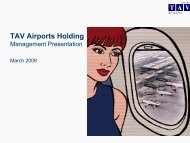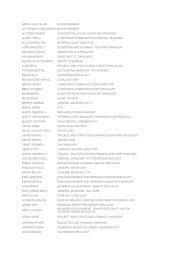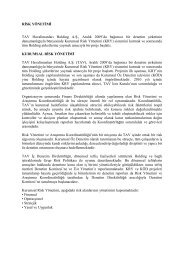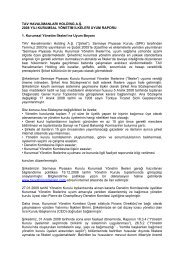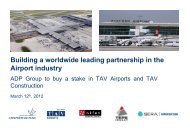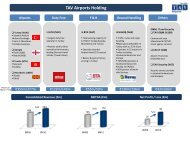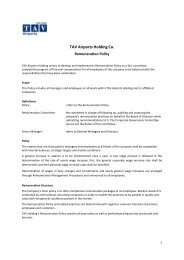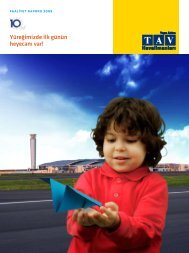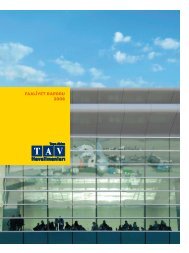TAV IT
TAV IT
TAV IT
You also want an ePaper? Increase the reach of your titles
YUMPU automatically turns print PDFs into web optimized ePapers that Google loves.
136<br />
<strong>TAV</strong> Airports Holding Annual Report 2008<br />
<strong>TAV</strong> AIRPORTS HOLDING AND <strong>IT</strong>S SUBSIDIARIES<br />
NOTES TO THE CONSOLIDATED FINANCIAL STATEMENTS<br />
AS AT AND FOR THE YEAR ENDED 31 DECEMBER 2008<br />
(Amounts expressed in Euro unless otherwise stated)<br />
Cash flow hedges<br />
Changes in the fair value of the derivative hedging instrument designated as a cash flow hedge are recognised directly in equity to<br />
the extent that the hedge is effective. To the extent that the hedge is ineffective, changes in fair value are recognised in profit or<br />
loss.<br />
If the hedging instrument no longer meets the criteria for hedge accounting, expires or is sold, terminated or exercised, then<br />
hedge accounting is discontinued prospectively. The cumulative gain or loss previously recognised in equity remains there until the<br />
forecast transaction occurs. When the hedged item is a non-financial asset, the amount recognised in equity is transferred to the<br />
carrying amount of the asset when it is recognised. In other cases the amount recognised in equity is transferred to profit or loss in<br />
the same period that the hedged item affects profit or loss.<br />
iii) Share capital:<br />
Ordinary shares are classified as equity.<br />
d) Property and equipment<br />
i) Recognition and measurement:<br />
Items of property and equipment are measured at cost less accumulated depreciation and accumulated impairment losses.<br />
Cost includes expenditure that is directly attributable to the acquisition of the asset. The cost of self-constructed assets includes<br />
the cost of materials and direct labour, any other costs directly attributable to bringing the asset to a working condition for its<br />
intended use, and the costs of dismantling and removing the items and restoring the site on which they are located. Purchased<br />
software that is integral to the functionality of the related equipment is capitalised as part of that equipment. Investment income<br />
earned on the temporary investment of specific borrowings pending their expenditure on qualifying amounts is deducted from the<br />
borrowing costs eligible for capitalisation.<br />
When parts of an item of property and equipment have different useful lives, they are accounted for as separate items (major<br />
components) of property and equipment.<br />
Gains and losses on disposal of an item of property and equipment are determined by comparing the proceeds from disposal with<br />
the carrying amount of property and equipment and are recognised net within “other operating income” in profit or loss.<br />
ii) Subsequent costs:<br />
The cost of replacing part of an item of property and equipment is recognised in the carrying amount of the item if it is probable<br />
that the future economic benefits embodied within the part will flow to the Group and its cost can be measured reliably. The<br />
carrying amount of the replaced part is derecognised. The costs of the day-to-day servicing of property and equipment are<br />
recognised in profit or loss as incurred.<br />
iii) Depreciation:<br />
Depreciation is recognised in profit or loss on a straight-line basis over the estimated useful lives of each part of an item of property<br />
and equipment. Leased assets are depreciated over the shorter of the lease term and their useful lives unless it is reasonably certain<br />
that the Group will obtain ownership by the end of the lease term. Land is not depreciated.



